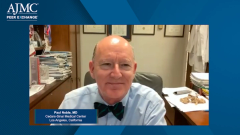
Payer Considerations Impacted by Updated ATS Guidelines
Paul Noble, MD, provides his closing thoughts on payer perspectives surrounding ILD, as well as considerations for the trajectory of ILD treatment landscape.
Episodes in this series

Paul Noble, MD: These updated guidelines have the potential to have some impact on clinical treatment. Practicing community physicians who are busy and see a variety of pulmonary diseases look to thought leaders and guidelines for help. The major take-home message is that if you have a patient with pulmonary fibrosis and you may not have a great feeling for what the underlying reason is, if they’re showing evidence of progression of disease, then it’s very reasonable to consider using nintedanib or pirfenidone. It’s important to follow these patients regularly. Patients will progress, but they progress at different rates.
Another major symptom is exertional breathlessness. Many of these patients are older and they may start to limit their exercise. They get out of breath when they do things, so they tend to be less active. That’s why it’s important to follow these patients every 3 or 4 months and do lung function and walk tests, in which you look at not only the distance but also what happens to their oxygen saturation. If you see patients progressing, then it’s important to think about a role for nintedanib or pirfenidone.
The horizon for IPF [idiopathic pulmonary fibrosis] is interesting. Most of the studies that are underway aren’t targeting the underlying cause. They’re focusing on medications that might slow the loss of lung function but be better tolerated. Although most recently, there was an early-stage study suggesting that medication targeting the activation of TGF-β with an endocrine-based approach showed that the drug seemed to be well tolerated over 12 weeks. Twelve weeks isn’t a long time in IPF. This important discovery was made 2 decades ago. Several companies have tried to develop integrin-based approaches to target pulmonary fibrosis, but all of them unfortunately failed in the clinic because of tolerability and safety issues. If it’s possible to target the activation of TGF-β with a safe medication, then that’s probably the most exciting development in addition to identifying approaches to targeting this regenerative process of the alveolar type 2 cell.
There have been some recent publications suggesting that pathways associated with aging might be activated in alveolar type 2 cells from patients with IPF, that they might prematurely age. There are approaches being developed for other diseases that are associated with aging. It’s exciting to start to think about ways to improve the function of those type 2 cells. They don’t work well. We know from studies that have used isolated type 2 cells from patients who have undergone lung transplant [and looked at] the explant tissue that the cells don’t regenerate properly. An approach that targets the activation of TGF-β and promotes alveolar type 2 cell regeneration offers the best potential to have a cystic fibrosis–like effect. Hopefully research in the years to come will focus on changing this paradigm away from only altering the loss of FVC [forced vital capacity] to trying to see people get better.
Transcript edited for clarity.
Newsletter
Stay ahead of policy, cost, and value—subscribe to AJMC for expert insights at the intersection of clinical care and health economics.









































